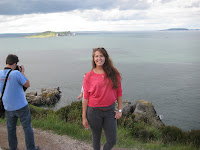September 1913
William Butler
Yeats
(1865-1939)
 |
| W.B. Yeats Home in Howth |
What need you, being come to sense,
But fumble in a greasy till
And add the halfpence to the pence
And prayer to shivering prayer, until
You have dried the marrow from the bone;
For men were born to pray and save;
Romantic Ireland's dead and gone,
It's with O'Leary in the grave.
Yet they were of a different kind,
The names that stilled your childish play,
They have gone about the world like wind,
But little time had they to pray
For whom the hangman's rope was spun,
And what, God help us, could they save?
Romantic Ireland's dead and gone,
It's with O'Leary in the grave.
Was it for this the wild geese spread
The grey wing upon every tide;
For this that all that blood was shed,
For this Edward Fitzgerald died,
And Robert Emmet and Wolfe Tone,
All that delirium of the brave?
Romantic Ireland's dead and gone,
It's with O'Leary in the grave.
Yet could we turn the years again,
And call those exiles as they were
In all their loneliness and pain,
You'd cry `Some woman's yellow hair
Has maddened every mother's son':
They weighed so lightly what they gave.
But let them be, they're dead and gone,
They're with O'Leary in the grave.
_________________________________________________________________________________
In 1907,
Sir Hugh Lane’s controversial act of lending his collection of modern French
paintings to the National Gallery in London, stirred W.B. Yeats into writing
five poems which later became his collection, Poems
Written in Discouragement. Perhaps most notably significant and certainly
the most well known of the five is “September 1913.” The poem itself is a
brilliant response to the public controversy surrounding the paintings, originally
intended for placement in Dublin, as well as Yeats’s perception of the then
current state of Ireland.
By way of
background, the paintings were first
offered to Dublin, but were met with public negativity. Being that the
paintings were French, some argued that Irish artists could produce paintings
as magnificent as those of Manet, Degas, and Renoir if they wanted to and could
not justify spending excessively for the temporary exhibition. Yeats, who held
great respect for Sir Lane, thought the public’s response was one of
“provincial complacency and malicious ignorance.” Furthermore, he believed that
this refusal to house a great collection was representative of the newly middle
class’s refusal of culture, education, and art to its place in the Irish
culture. But this was just the
inspiration of the succession of five poems.
“September
1913” transforms Yeats’s views of the Irish mentality and morality and specific
events and issues into a political ballad. The poem marks the change in
Yeats’s political views from an aristocratic idealization of Ireland to a more
revolutionary tone. Majority of the content of the poem is condemning the upper class bourgeois for the hoarding of money in their “greasy till…adding
halfpence to the pence.” By not giving back to the community the aristocratic
upper class has “dried the marrow from the bone” of those in the lower classes. But it is the last two lines
of each stanza that are the most significant, “ Romantic Ireland’s dead and
gone, It’s with O’Leary in the grave.” The lines are used as a pause, or
breaking point to have the reader focus and reflect on the content of the first
six lines. Repetition is significant in that it solidifies Yeats’s views after
each point is made.
From what
we studied in lecture on W.B. Yeats, I had the ignorant idea that all of his
poems would be centered around mysticism and romanticizing Ireland. By
happenstance, I came across “September 1913” after listening to a contemporary
Irish rap compilation in our culture class, which borrows the line “Romantic
Ireland’s dead and gone, It’s with O’Leary in the grave.” I recognized the
line, but thought that it had come from a bleaker poet that we had studied than Yeats. After doing
some research into his later career, I was somewhat shocked to find that he had
completely changed his view of Ireland and no longer romanticized the Irish
country side like so many of his early words did. There is a parallel between “romantic
Ireland is dead and gone” describing not only the events portrayed in the poem,
but also Yeats’s distancing himself from that part of his identity. It is
fascinating how in his early years he struggled so much with identity, always
wanting to be accepted into the landed gentry of his mother’s familial history,
and later strayed as far from that lineage as possible.























